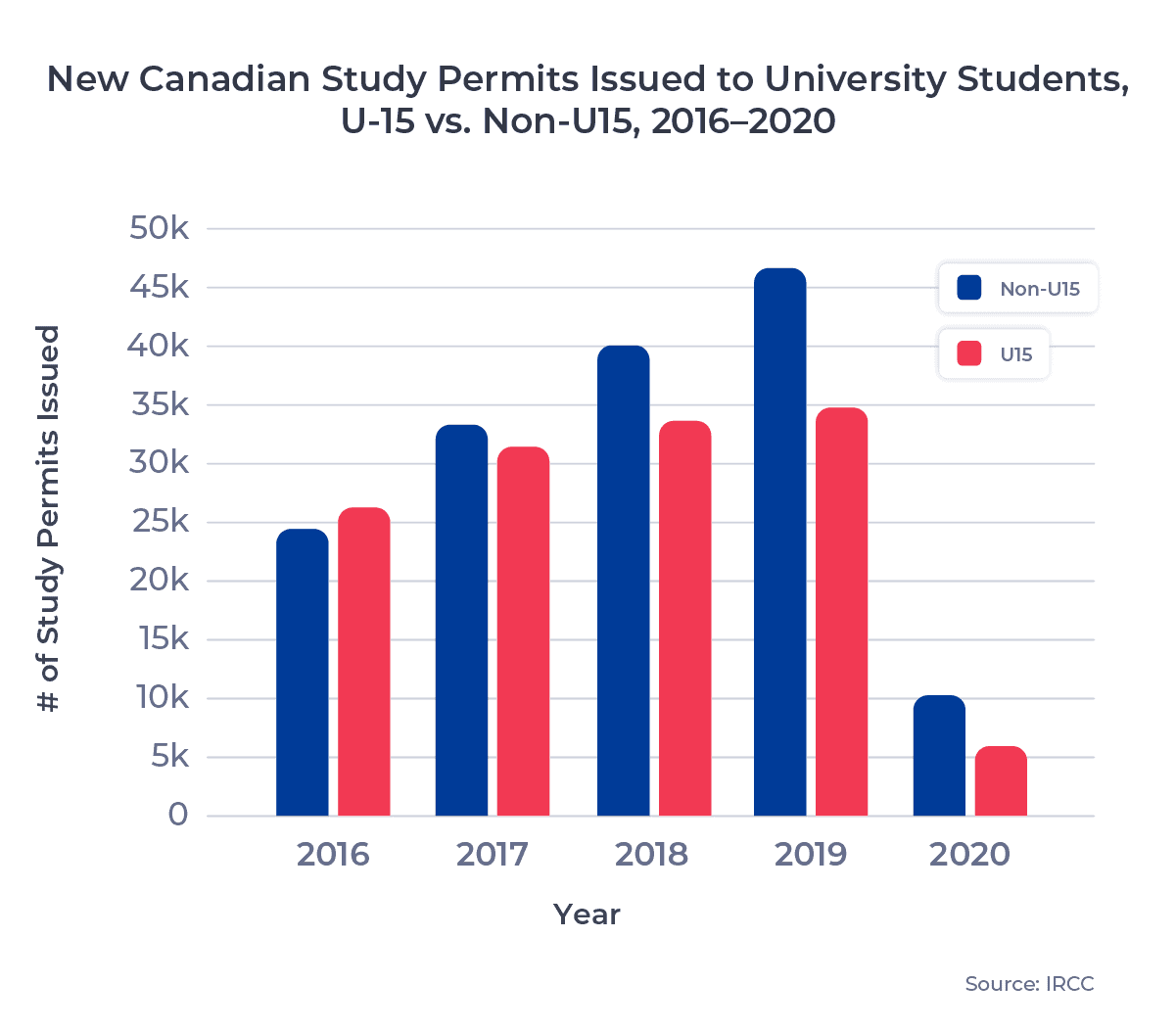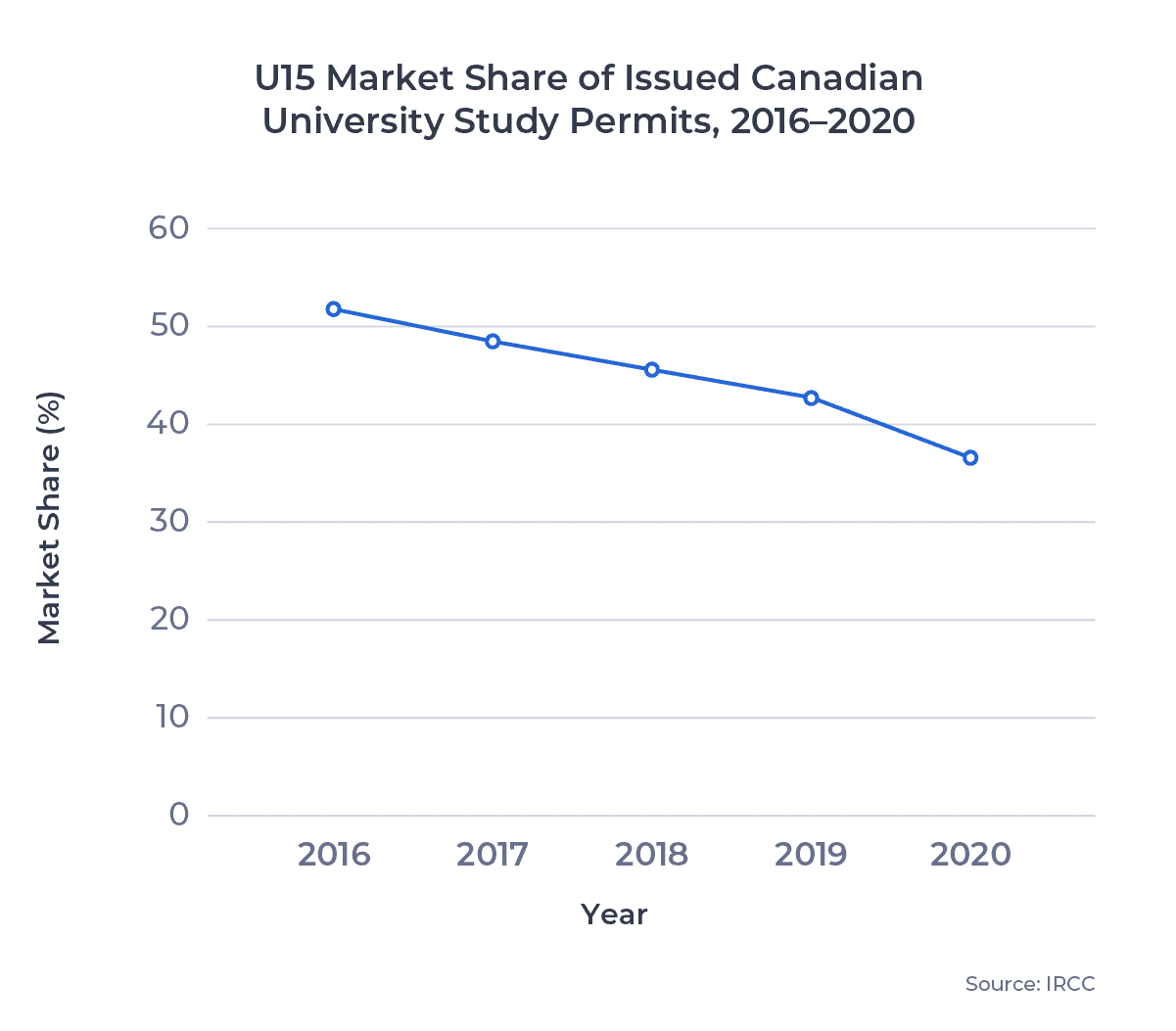International student interest in studying at Canadian universities has risen substantially over the past five years. In 2016, around 66,000 international students applied for study permits for Canadian undergraduate and graduate programs.1 By 2019, that number had risen to over 115,000, with more than 73,000 students applying just for undergraduate programs.
It’s clear that Canada remains a top destination for university students. But are students still choosing the same universities for their studies, and how are student trends impacting the institutions themselves? In this edition of ApplyInsights, I’ll be taking a closer look at international student growth at Canadian universities and analyzing how U15 institutions have fared compared to the rest of the Canadian university sector.
Key Insights at a Glance
- The U15’s share of Canadian study permits issued to university students fell from 52% in 2016 to 37% in 2020.
- The drop in U15 institutions’ market share resulted in more than 16,000 international students enrolling at non-U15 universities between 2017 and 2020.
- An additional 16,000 students would have provided U15 institutions with around $1.9B in tuition fees between 2017 and 2020.
Throughout this article, I’ll look at pre-pandemic and 2020 trends that impacted Canadian universities and the U15 specifically. I’ll also analyze the impact of slower international student growth at U15 schools on Canada’s university landscape, and give my thoughts on what U15 schools can do to increase their student diversity.
For more information on the U15, take a look at our last article on the rising popularity of health studies at U15 schools over the past five years.
International Student Growth in Canada’s University Sector
Canada’s university sector experienced substantial international student growth between 2016 and 2019. Over that span, the total number of new Canadian study permits issued to university students increased by 60.1%. The chart below shows the number of study permits issued from 2016 to 2020 for all universities and U15 schools:

Slower Growth at U15 Institutions
Pre-pandemic growth showed that interest in Canadian university studies was high and growing, and I expect the university sector to rebound quickly post-pandemic. But it may take longer for U15 institutions to rebuild their international student populations after the pandemic, based on pre-pandemic trends. Compared to non-U15 universities, U15 schools experienced slower international student growth. International students enrolling at U15 institutions received 34,782 new study permits in 2019, up from 26,264 in 2016.
This 32.4% increase is a positive sign, but it was only a third of the growth rate for non-U15 universities, which collectively achieved 91.0% growth in study permits issued from 2016 to 2019. This slower growth, compounded with greater pandemic-related loss, could have a substantial impact on U15 universities over the next five years.
Study Permit Market Share for U15 on the Decline
Rapid non-U15 university student growth and slow U15 growth has caused U15 schools to lose international student market share. In 2016, U15 schools accounted for 51.8% of all new study permits issued to university students. By 2019, this rate had fallen to 36.7%. The chart below shows the U15 market share of all new permits issued to university students between 2016 and 2020:

The pandemic has accelerated the U15 market share decline. Between 2016 and 2019, U15 schools lost around 3% market share per year. From 2019 to 2020, U15 universities lost twice that amount, falling 6% year-over-year.
Using 2020 study permit numbers as a baseline, we can project how long it will take the Canadian university market to recover. If we assume Canadian universities will recover at the same rate they grew between 2016 and 2019, non-U15 universities would take just over two years to return to pre-pandemic international student numbers. For U15 institutions, it would take more than five years.
The Cost of a Lower Market Share for U15 Schools
This loss of market share, and slower projected recovery, has had a significant impact on tuition fees collected by U15 schools. The table below shows how many additional students would have attended U15 institutions if the U15 had maintained their 2016 international student market share through to 2020:
| 2016 Market Share | Actual Market Share | Difference | |
|---|---|---|---|
| 2017 | 33,551 | 31,443 | -2,108 |
| 2018 | 38,199 | 33,649 | -4,550 |
| 2019 | 42,196 | 34,782 | -7,414 |
| 2020 | 8,385 | 5,929 | -2,456 |
In total, U15 universities missed the opportunity to enroll 16,528 international students between 2017 and 2020. But these 16,528 students still came to Canada and enrolled at a Canadian university. What if they had attended a U15 institution? How does this loss of potential students impact the bottom line of U15 universities?
The table below shows a conservative calculation of how much additional tuition U15 schools could have collected. This calculation is based on the average international student tuition at Canadian universities in each year, assuming each student completed a four-year undergraduate degree:
| International Student Tuition* | International Students Lost | Total Tuition Lost | |
|---|---|---|---|
| 2017 | $25,549 | 2,108 | -$215.4M |
| 2018 | $27,613 | 4,550 | -$502.6M |
| 2019 | $29,883 | 7,414 | -$886.2M |
| 2020 | $32,019 | 2,456 | -$314.6M |
| * Based on Canadian national average, assigning four years of tuition costs to each student in the year they would have started their studies | |||
Between 2017 and 2020, U15 universities lost out on more than $1.9B in potential tuition. Unless U15 schools recapture significant market share through substantial recovery and growth, potential tuition lost will only climb in the years to come.
Major Risk Factors for U15 Institutions
Potential tuition loss is not the only major outcome of lower international student market share for U15 schools. Though many U15 institutions have rich histories of multiculturalism, their falling shares of the international student market could jeopardize long-term diversity. Non-U15 universities are increasing their new cultural diversity at a much faster pace.
This loss of market share also reflects that Canada’s best research institutions may be missing out on some of the world’s top students. As universities around the world compete for top talent, the rising price of tuition for international students at Canada’s universities has become a critical concern. Many U15 institutions have international student tuition rates above the national average, meaning a four-year undergraduate degree could cost international students more than $250,000 in tuition and fees. Here at ApplyBoard, we’ve seen a marked increase in student searches for programs that cost less than $50,000 per year since the start of the pandemic.
This is all at a time when, according to the 2020 QS International Student Survey (ISS), affordable tuition and school rankings hold near equal weight for students considering where to study abroad. Crucially, this survey also showed that students consider their field of study and destination country before they look at which specific institution they want to apply to. While the popularity of health studies and business studies continue to grow, these programs can have higher tuition fees, and U15 schools may be pricing themselves out of top talent.
How U15 Universities can Attract More International Students
Recapturing a larger portion of Canada’s international student market will be a growing priority for U15 schools. Doing so will entail demonstrating the value associated with their higher tuition fees. They need to show prospective students that an education from a U15 school can lead to better job opportunities and stronger alumni networks. They need to not only frame themselves against other Canadian universities, but also leading universities in the US, the UK, and Australia.
But U15 schools also need to look at diversifying their reach. Introducing more needs-based scholarships could help U15 institutions attract top students from lower income backgrounds, which will be increasingly important as the pandemic has eroded economies around the world.
Increased financial accessibility could also allow U15 universities to recruit from more diverse source markets with strong growth potential and reduce their current reliance on declining markets. I’ll be looking at source market opportunities and risks for U15 institutions in a future ApplyInsights, so stay tuned!
To attract diverse applicants and increase their international student enrollment, I recommend U15 schools:
- Open more spots in popular programs, such as health studies and business programs, to international students.
- Offer more needs-based scholarships so that U15 institutions are affordable for students with less disposable capital.
- Increase recruitment efforts in growing markets to drive increased campus diversity and future growth.
Global brands, top facilities, and university rankings will only go so far in attracting international students in a post-COVID world. The pandemic has forced many universities and colleges to think differently about international recruitment. The U15, while strong and talented, are not immune to this challenge.
Published: April 23, 2021
Subscribe to ApplyInsights
Sign up for the latest insights on international education.
 Meti Basiri
Meti Basiri
Co-Founder and Chief Marketing Officer (CMO)
Meti is driven by the belief that education is a right, not a privilege. He leads the International Recruitment, Partner Relations, and Marketing teams at ApplyBoard, working to make education accessible to people around the world. Meti has been instrumental in building partnerships with 1,500+ educational institutions across Canada, the United, the United Kingdom, and Australia. Working with over 5,000 international recruitment partners, ApplyBoard has assisted over 150,000 students in their study abroad journey. Follow Meti on LinkedIn for more access to ApplyInsights and key industry trends.
FOOTNOTES:
1. Statistics used in this article are for new study permits only. All data courtesy of Immigration, Refugees and Citizenship Canada (IRCC), except where noted.



